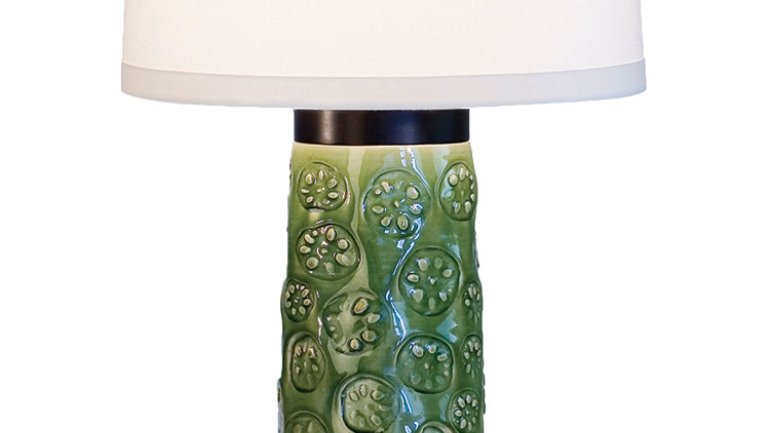Cool Lines, Warm Light
Cool Lines, Warm Light
With their tactile surfaces and modern silhouettes, Lesley Anton’s lamps are subtle without being wallflowers; they’re striking and sculptural without stealing the limelight. “There’s a trend in new house design,” says ceramist Anton, “where the interior is modern or even midcentury-influenced, and a neutral palette and clean, often chrome, surfaces create a cool space. My lamps shed light and bring warmth to a room,” she explains. Her line, which includes floor, table, and pendant lamps, embodies an aesthetic she describes as “organic modern,” two words that stake out her territory between the chilly minimalism of the modern and the warm imperfections of the natural world.
Anton’s creative process is a savvy blend of strong design – she cites influences ranging from traditional lamps to trips to the desert and the junkyard – and informal market research in showrooms where she considers form and pricing. Her first lamps came out of a chance visit to a Los Angeles interiors showroom more than a decade ago. “There weren’t a lot of ceramic lamps in the showroom, and those that were there were brightly colored, slip-cast lamps selling at high price points,” she says.
Anton had recently arrived in Los Angeles, after seven years as a flight attendant based in New York City. During that time, she had studied ceramics at the 92nd Street Y, focusing on dinnerware fashioned on the wheel with a handmade heft and contemporary lines. Now, new to LA and unemployed, she decided to make a ceramic lamp, but with a twist: She envisioned a Japanese aesthetic and a high-fire reduction glaze, which makes the surface richly tactile. She had nothing but a hunch that her lamp would fill a waiting niche.
That hunch took shape in Anton’s first two table lamps, the Cone and the Lotus, which remain part of her line. Strong and sculptural, with an elegant and slightly retro profile, the lamps combine wheel-thrown porcelain with walnut-stained alder wood. In 2001, she found representation with De Sousa Hughes, and Lesley Anton was in business. Now represented in showrooms across the country, her line has grown to include 20 table and six floor lamps that evoke bamboo, hobnail bottles, and modernist totems. She added three versions of ceiling pendants to meet what she saw as a need in the market. “I wanted to create a ceiling piece, so I looked at a lot of historically modern pendants, thinking of how I could make a ceramic pendant lamp that feels both unique and familiar.” With their octopus-like tangle of stainless steel wires connected to a nest of porcelain shades, her pendants (Blossom, Barnacle, and Ribbon) allude to home furnishings design firm Droog’s chandelier, made from wires and bulbs; but they add color, texture, and natural references.
Working from a 900-square-foot studio near her home in the Miracle Mile neighborhood of Los Angeles, two studio assistants help Anton fill a consistent and growing number of orders. Before the economic downturn in 2008, Anton filled larger-scale commissions for high-end hotel interiors, including the MGM Grand in Las Vegas. More recently, she’s gotten lamp orders from private clients who find her work through showrooms and interior designers. She has also added a line of functional ware. “It’s modern in conception but with the same handmade quality as the lamps,” she says. Her place settings, small sculptural objects, vases, and containers for the kitchen are sold through 30 retail stores across the country and directly through her studio.
In a typical month, Anton gets orders for as many as 20 lamps, but she makes more to end up with the best crop. “If there’s a pair, that’s particularly challenging,” she explains, “because I’ll have to make more than two to find two that will look close enough to each other.”
Anton spends her days seeking a careful balance between such precision and the beauty of irregularity. Now completing orders for functional ware as well as multiple lamps for two houses in Mexico City, she finds herself with almost more orders than she can handle. It’s a dilemma she appreciates. “Good design is available inexpensively now. For the person who wants my lamps or my dinner plates, it’s a sign that they are connected in some way to the idea of the handmade and how that can bring beauty to everyday life. And that’s lovely.”
Kira Obolensky is a playwright and writer based in Minneapolis.

